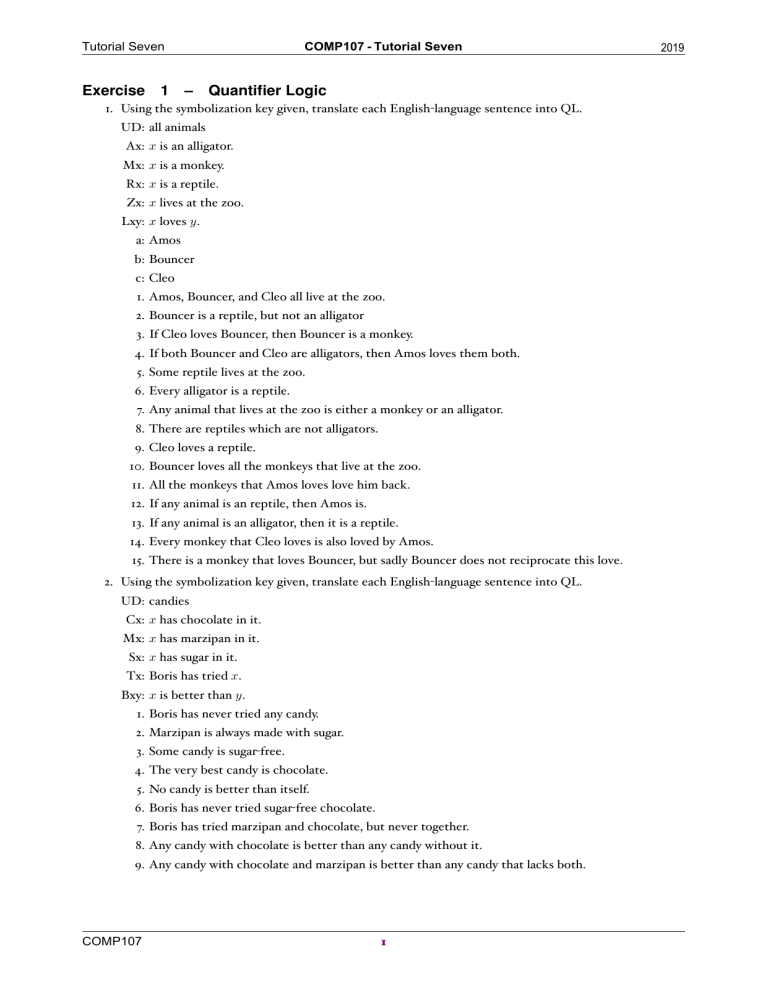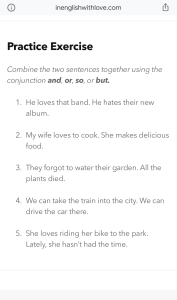
COMP107 - Tutorial Seven Tutorial Seven Exercise 1 – Quantifier Logic 1. Using the symbolization key given, translate each English-language sentence into QL. UD: all animals Ax: x is an alligator. Mx: x is a monkey. Rx: x is a reptile. Zx: x lives at the zoo. Lxy: x loves y . a: Amos b: Bouncer c: Cleo 1. Amos, Bouncer, and Cleo all live at the zoo. 2. Bouncer is a reptile, but not an alligator 3. If Cleo loves Bouncer, then Bouncer is a monkey. 4. If both Bouncer and Cleo are alligators, then Amos loves them both. 5. Some reptile lives at the zoo. 6. Every alligator is a reptile. 7. Any animal that lives at the zoo is either a monkey or an alligator. 8. There are reptiles which are not alligators. 9. Cleo loves a reptile. 10. Bouncer loves all the monkeys that live at the zoo. 11. All the monkeys that Amos loves love him back. 12. If any animal is an reptile, then Amos is. 13. If any animal is an alligator, then it is a reptile. 14. Every monkey that Cleo loves is also loved by Amos. 15. There is a monkey that loves Bouncer, but sadly Bouncer does not reciprocate this love. 2. Using the symbolization key given, translate each English-language sentence into QL. UD: candies Cx: x has chocolate in it. Mx: x has marzipan in it. Sx: x has sugar in it. Tx: Boris has tried x. Bxy: x is better than y . 1. Boris has never tried any candy. 2. Marzipan is always made with sugar. 3. Some candy is sugar-free. 4. The very best candy is chocolate. 5. No candy is better than itself. 6. Boris has never tried sugar-free chocolate. 7. Boris has tried marzipan and chocolate, but never together. 8. Any candy with chocolate is better than any candy without it. 9. Any candy with chocolate and marzipan is better than any candy that lacks both. COMP107 1 2019 Tutorial Seven COMP107 - Tutorial Seven 3. Using the symbolization key given, translate each English-language sentence into QL. UD: people Dx: x dances ballet. Fx: x is female. Mx: x is male. Cxy: x is a child of y . Sxy: x is a sibling of y . e: Elmer j: Jane p: Patrick 1. All of Patrick’s children are ballet dancers. 2. Jane is Patrick’s daughter. 3. Patrick has a daughter. 4. Jane is an only child. 5. All of Patrick’s daughters dance ballet. 6. Patrick has no sons. 7. Jane is Elmer’s niece. 8. Patrick is Elmer’s brother. 9. Patrick’s brothers have no children. 10. Jane is an aunt. 11. Everyone who dances ballet has a sister who also dances ballet. 12. Every man who dances ballet is the child of someone who dances ballet. COMP107 2 2019 Tutorial Seven COMP107 - Tutorial Seven Answer of exercise 1 1. (a) Za ∧ Zb ∧ Zc (b) Rb ∧ ¬Ab (c) Lcb → M b (d) (Ab ∧ Ac) → (Lab ∧ Lac) (e) ∃x(Rx ∧ Zx) (f) ∀x(Ax → Rx) [ ] (g) ∀x Zx → (M x ∨ Ax) (h) ∃x(Rx ∧ ¬Ax) (i) ∃x(Rx ∧ Lcx) [ ] (j) ∀x (M x ∧ Zx) → Lbx [ ] (k) ∀x (M x ∧ Lax) → Lxa (l) ∃xRx → Ra (m) ∀x(Ax → Rx) [ ] (n) ∀x (M x ∧ Lcx) → Lax (o) ∃x(M x ∧ Lxb ∧ ¬Lbx) 2. (a) ¬∃xT x (b) ∀x(M x → Sx) (c) ∃x¬Sx (d) ∃x[Cx ∧ ¬∃yByx] (e) ¬∃xBxx (f) ¬∃x(Cx ∧ ¬Sx ∧ T x) (g) ∃x(Cx ∧ T x) ∧ ∃x(M x ∧ T x) ∧ ¬∃x(Cx ∧ M x ∧ T x) (h) ∀x[Cx → ∀y(¬Cy → Bxy)] ( ) (i) ∀x (Cx ∧ M x) → ∀y[(¬Cy ∧ ¬M y) → Bxy] 3. (a) ∀x(Cxp → Dx) (b) Cjp ∧ F j (c) ∃x(Cxp ∧ F x) (d) ¬∃xSxj [ ] (e) ∀x (Cxp ∧ F x) → Dx (f) ¬∃x(Cxp ∧ M x) (g) ∃x(Cjx ∧ Sxe ∧ F j) (h) Spe ∧ M p [ ] (i) ∀x (Sxp ∧ M x) → ¬∃yCyx (j) ∃x(Sxj ∧ ∃yCyx ∧ F j) [ ] (k) ∀x Dx → ∃y(Sxy ∧ F y ∧ Dy) [ ] (l) ∀x (M x ∧ Dx) → ∃y(Cxy ∧ Dy) COMP107 3 2019
